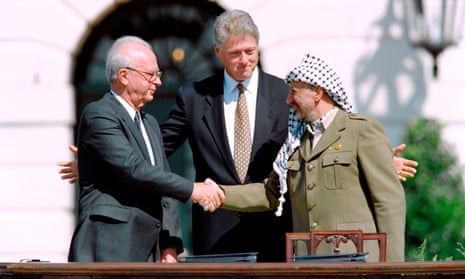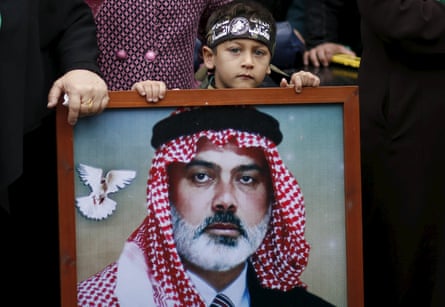What are the roots of the Israel-Palestine conflict?
"The horrific events over the last week are the culmination of a decades-long clash in the disputed region of the Middle East

As with almost everything to do with this conflict, it depends on whom you ask.
Some will begin with the Romans. Others will start with the late 19th-century Jewish migration to what was then the Ottoman Empire – to escape the pogroms and other persecutions in eastern Europe – and the rise of Zionism. Or the Balfour declaration by the British government in 1917 in support of a “national home for the Jewish people” in Palestine and the ensuing conflicts with Arab communities there.
But the starting point for many people is the United Nations’ vote in 1947 to partition land in the British mandate of Palestine into two states – one Jewish, one Arab – following the destruction of much of European Jewry in the Holocaust.
Neither the Palestinians nor the neighbouring Arab countries accepted the founding of modern Israel. Fighting between Jewish armed groups, some of which the British regarded as terrorist organisations, and Palestinians escalated until the armies of Egypt, Iraq, Transjordan and Syria invaded after Israel declared independence in May 1948.
With Israel’s new army gaining ground, an armistice agreement in 1949 saw new de facto borders that gave the fledgling Jewish state considerably more territory than it was awarded under the UN partition plan.
About 700,000 Palestinians were expelled or fled – about 85% of the Arab population of the territory captured by Israel – and were never allowed to return.
Palestinians called the exodus and eradication of much of their society inside Israel the Nakba, or “catastrophe”, and it remains the traumatic event at the heart of their modern history.
Arabs who remained in Israel as citizens were subject to official discrimination. They were placed under military rule for nearly two decades, which deprived them of many basic civil rights. Much of their land was expropriated and Arab Israeli communities were deliberately kept poor and underfunded.
What is the Palestine Liberation Organisation?
In 1964, a coalition of Palestinian groups founded the Palestine Liberation Organisation under the leadership of Yasser Arafat to pursue armed struggle and establish an Arab state in place of Israel. The PLO drew international attention to its cause with high-profile attacks and hijackings.
How did the occupied Palestinian territories become occupied?
In 1967, Israel launched what it said was a pre-emptive defensive war against Jordan, Egypt and Syria, as they appeared to be preparing to invade. The attack caught Arab governments by surprise and saw Israel achieve rapid victories including seizing the Sinai peninsula and the Gaza Strip from Egypt, the Golan Heights from Syria, and the West Bank and East Jerusalem from Jordan. The six-day war was a spectacular military success for Israel. Its capture of all of Jerusalem and newly acquired control over the biblical lands called Judea and Samaria in Israel opened the way to the construction of Jewish settlements in the West Bank, which became central to the conflict.
Israel placed the Arab population of the West Bank under military rule, which is enforced to this day.
When did Hamas enter the picture?
The PLO was a generally secular organisation modelled on other leftwing guerrilla movements of the time, although most of its supporters were Muslim.

Islamist groups such as the Muslim Brotherhood had previously avoided armed conflict and were largely dedicated to working for a more religious society. But that position shifted under the leadership of Sheikh Ahmed Yassin, a charismatic quadriplegic living in Gaza who helped found several Islamist organisations in Gaza including Mujama al-Islamiya, which won support by establishing a network of social services including schools, clinics and a library.
Shortly after the outbreak of the first intifada, Yassin used support for Mujama al-Islamiya as the foundation for the formation of Hamas in 1987 in alliance with other Islamists.
Israel has always denied encouraging the rise of the Islamist movement in Gaza but it saw the groups as a way of undermining support for the PLO and recognised Mujama al-Islamiya as a charity, allowing it to operate freely and build support. Israel also approved the creation of the Islamic University of Gaza, which became a breeding ground of support for Hamas.
What was the first intifada?
Israel regarded the Palestinian population under its control as largely quiescent even as it went on expanding Jewish settlements in Gaza and the West Bank and expropriating Arab land. Palestinians were also treated as a cheap source of largely manual labour inside Israel.
That illusion was shattered in 1987 as young Palestinians rose up. The uprising was marked by mass stone throwing. The Israeli army responded with large-scale arrests and collective punishments.
The intifada is largely recognised as a success for the Palestinians, helping to solidify their identity independently of neighbouring Arab states and forcing Israel into negotiations.
It also strengthened Arafat’s hand to make compromises with Israel, including adopting the principle of a two-state solution.
Whatever happened to the peace process?
As the first intifada wound down in 1993, the Oslo peace process started with secret talks between Israel and the PLO. Israel’s then prime minister, Yitzhak Rabin, signed an agreement with Arafat aimed at fulfilling the “right of the Palestinian people to self-determination” although Rabin did not accept the principle of a Palestinian state.
The Oslo accords established the Palestinian National Authority, granting limited self-governance over patches of the West Bank and Gaza Strip. Further negotiations were intended to resolve issues such as the status of Jerusalem, the future of the Israeli settlements and the right of return for the millions of Palestinians still classified as refugees after their forebears were never permitted to return to their homes.
Some prominent Palestinians regarded the accords as a form of surrender while rightwing Israelis opposed giving up settlements or territory.
Among Israelis, the political charge against Oslo was led by future prime ministers Ariel Sharon and Benjamin Netanyahu, who fronted rallies at which Rabin was portrayed as a Nazi. Rabin’s widow blamed the two men for her husband’s assassination by an ultranationalist Israeli in 1995.
What caused the second intifada?
Peace negotiations sputtered along until the failure of Bill Clinton’s attempts to broker a final deal at Camp David in 2000, which contributed to the outbreak of the second intifada. The uprising was markedly different from the first intifada because of widespread suicide bombings against Israeli civilians launched by Hamas and other groups, and the scale of Israeli military retaliation.
By the time the uprising ended in 2005, more than 3,000 Palestinians and 1,000 Israelis were dead.
The political ramifications of the intifada were significant. It led to a hardening of attitudes among ordinary Israelis and the construction of the West Bank barrier. But it also prompted then prime minister Ariel Sharon to say that Israel could not go on occupying the Palestinians’ territory – although he did not say that the alternative was an independent Palestinian state.
Is Gaza still occupied?
One consequence of the second intifada was Sharon’s decision to “disengage” from the Palestinians beginning in 2005 with the closing of Israeli settlements in Gaza and parts of the northern West Bank. It is not clear how much further Sharon would have gone with this policy as he had a stroke and went into a coma the following year.
The status of Gaza since the disengagement remains disputed. Israel says it is no longer occupied. The United Nations says otherwise because of Israel’s continued control of airspace and territorial waters, and also access into the territory, along with Egypt. Israeli has also blockaded the enclave since Hamas came to power in 2006.
In addition, many Palestinians in Gaza do not see themselves as a separate entity from the rest of their territories in the West Bank and East Jerusalem and so argue that as a whole they remain occupied.
Why does Hamas control Gaza?
Hamas won the 2006 Palestinian legislative elections in part because of a backlash against the corruption and political stagnation of the ruling Fatah party. The Hamas leader Ismail Haniya was appointed prime minister. Israel began arresting Hamas members of the Palestinian parliament and imposed sanctions against Gaza.
Deteriorating relations between Hamas and Fatah resulted in violence. An agreement to form a national unity government fell apart and Hamas led an armed takeover of Gaza while Fatah continued to control the Palestinian Authority in the West Bank. There have been no elections since.
Hamas has continued to attack Israel from Gaza, mostly using rockets until the latest ground incursion. Israel has maintained a tight blockade of the territory which has contributed to deteriorating living conditions and deepening poverty.
Where are we now?
Although western governments still pay lip service to a two-state solution, there has been no progress toward an agreement under Israel’s longest-serving prime minister, Benjamin Netanyahu, who has repeatedly said he will never accept a Palestinian state.
His present government includes far-right parties that openly advocate the annexation of all or part of the West Bank to Israel and the continued governance of the Palestinians without full rights or the vote. Israeli and foreign human rights groups say Israel has increasingly carved out a form of apartheid in the occupied territories.
Hamas’s killing of more than 1,200 Israelis now moves the conflict into uncharted territory."
No comments:
Post a Comment